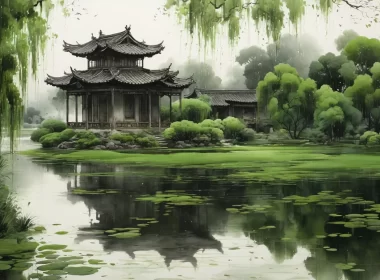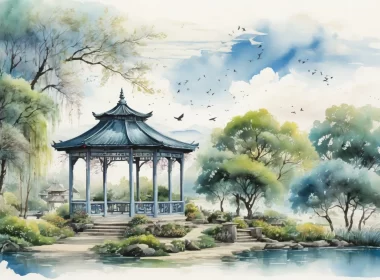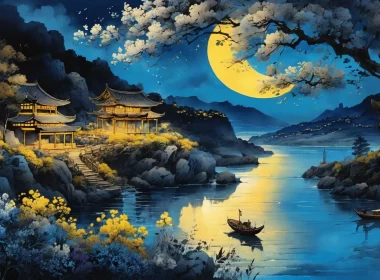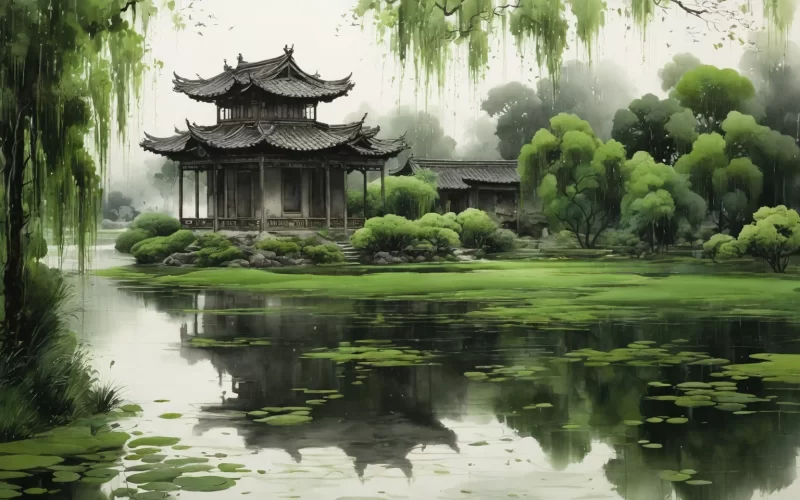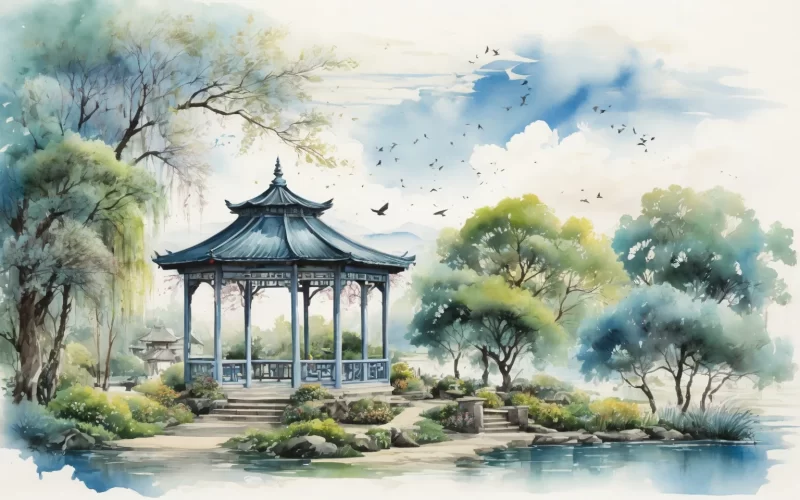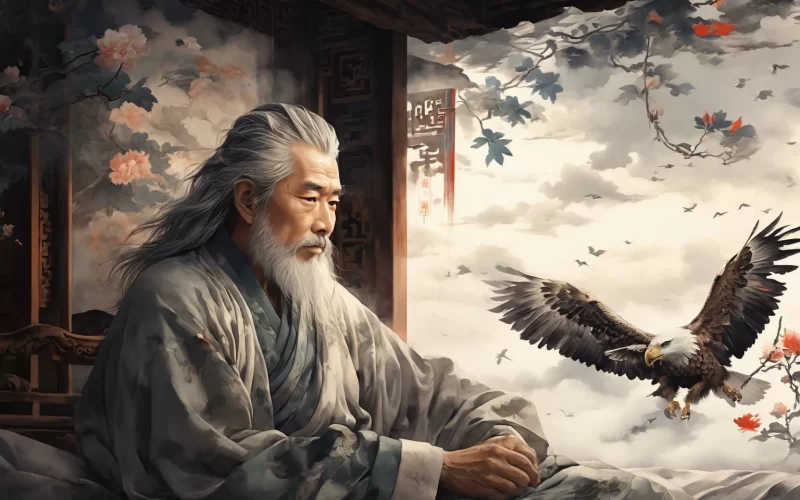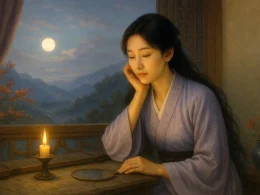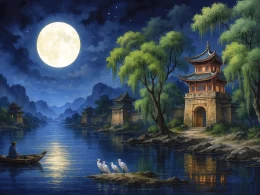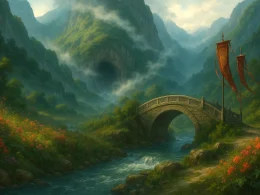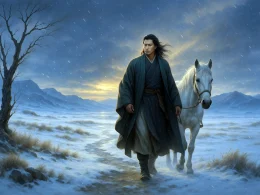The ancient garden and the ruin’d terrace willows green;
The water-chestnut gatherers’ song is sung in spring.
There’s nothing but the moon that shines on the stream,
That once on the fair ladies in the Palace of the King.
Original Poem
「苏台览古」
李白
旧苑荒台杨柳新,菱歌清唱不胜春。
只今惟有西江月,曾照吴王宫里人。
Interpretation
This enduring nostalgic poem captures Li Bai's visit to the Gusu Terrace, where he reflects upon the past splendor of King Fuchai of Wu and the legendary beauty Xi Shi, now replaced by desolation. The poet seamlessly blends profound reflections on historical rise and fall into a vibrant spring landscape, creating powerful emotional tension and expressing a deep understanding of prosperity's inevitable decline and life's impermanence.
First Couplet: "旧苑荒台杨柳新,菱歌清唱不胜春。"
Jiù yuàn huāng tái yángliǔ xīn, líng gē qīng chàng bùshèng chūn.
The old garden, ruined terrace, willows anew; Fresh water chestnut songs seem overwhelmed by spring.
The couplet opens with stark sensory contrasts. "Old garden, ruined terrace" represents heavy historical remnants—scars of faded glory—while "willows anew" proclaim nature's eternal cycle with vibrant life. The juxtaposition of decaying ruins and fresh growth evokes a profound sense of history. The "fresh songs" depict cheerful folk life, yet "overwhelmed by spring" lends the season an unbearable weight—the more intense the spring beauty, the more it highlights the desolation of history, allowing the poet's melancholy to spread subtly within the seemingly bright scene.
Second Couplet: "只今惟有西江月,曾照吴王宫里人。"
Zhǐ jīn wéiyǒu xī jiāng yuè, céng zhào Wú wáng gōng lǐ rén.
Now, only the moon over the western river remains, Which once shone on those within the King of Wu's palace.
The poet's focus shifts abruptly from the broad spring scene to the eternal moon. "Only" carries immense weight, eliminating all transient things and leaving the moon as the sole constant witness. The moon rising over the "western river" creates a more specific and vast setting. It acts as a calm eye that once watched the singing, dancing, and beauties of the Wu Palace and now gazes upon the broken walls. In this silent contrast, the extreme prosperity of the past and the complete silence of the present are illuminated by the same moonlight, conveying the fragility and impermanence of human affairs without explicit statement.
Holistic Appreciation
This poem is a model of Li Bai's nostalgic verse, renowned for its effortless grace and subtle artistry. It employs contrast throughout but with layered emotional expression. The first line contrasts "ruined terrace" and "new willows" to set the tone of rise and fall; the second uses cheerful songs to contrast the poet's inner solemnity—writing sorrow through joyful scenery. The final couplet is a stroke of genius, pushing temporal depth to its extreme: the moon's "permanence" contrasts with human life's "transience." Without directly expressing lament, the poem allows the vast shifts of history and the sense of life's emptiness to permeate the lines through the juxtaposition of images, achieving the artistic realm where "words end but meaning lingers."
Artistic Merits
- Multi-Dimensional Contrast: The poem builds layered contrasts between "old" and "new" (time), "ruin" and "spring" (scene), and "human world" and "moon" (eternity vs. transience), intensifying the theme progressively.
- Deliberate Imagery Selection: "Willows" symbolize nature's constancy, "folk songs" represent daily life, and the "western river moon" serves as a timeless witness—together forming a rich symbolic system that carries the poet's philosophy.
- Emotion Through Scene, Subtle and Profound: The poet ultimately entrusts all historical sentiment and life reflections to the image of the moon, avoiding direct expression and letting the scenery speak for itself, resulting in a resonant conclusion that sparks endless imagination.
- Skillful Temporal Compression: The compression of the past ("those within the King of Wu's palace") and the present ("only the moon remains") into the moment of "once shone" creates a powerful sense of temporal collision.
Insights
Transcending mere nostalgia, this poem elevates into a meditation on life and existence. It reminds us that personal joys and sorrows, like the rise and fall of dynasties, are fleeting against nature's permanence (moon, willows) and the continuity of life (folk songs). It guides us not toward pessimism but toward a detached and philosophical mindset in facing life's fluctuations and era changes. Recognizing our smallness and life's brevity, we may cherish present realities and emotions more deeply, unshackled by fading vanities. True eternity may lie within this seemingly ordinary cycle of life.
About the poet
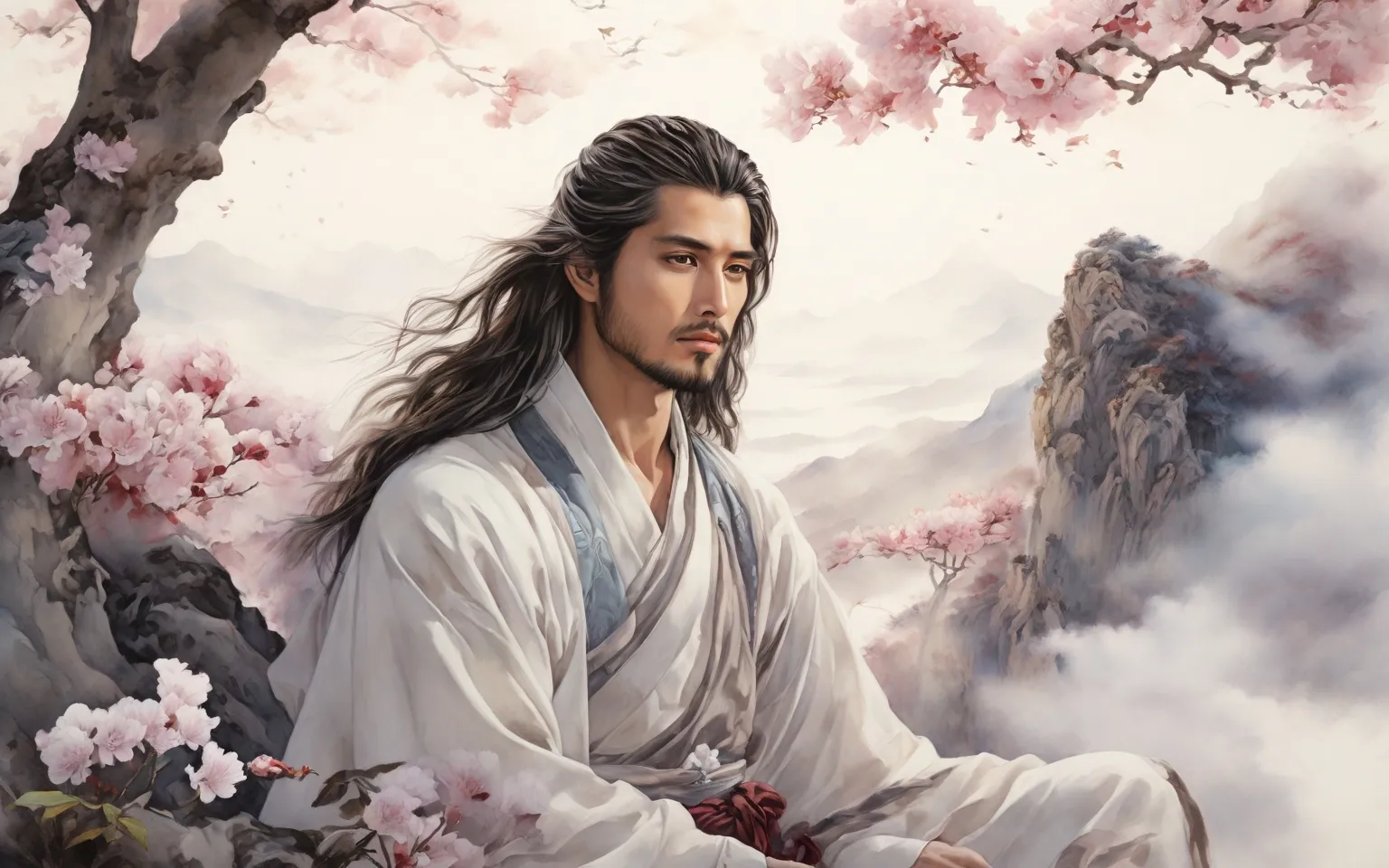
Li Bai (李白), 701 - 762 A.D., whose ancestral home was in Gansu, was preceded by Li Guang, a general of the Han Dynasty. Tang poetry is one of the brightest constellations in the history of Chinese literature, and one of the brightest stars is Li Bai.



